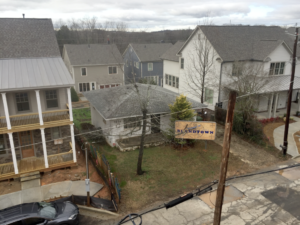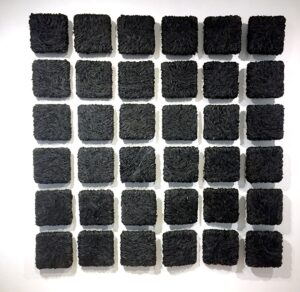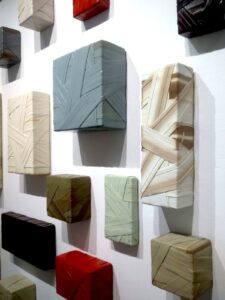In a new exhibition at Gallery 72, artist Gregor Turk confronts Atlantans with the erasure of an African-American neighborhood, its history, and even its name. By Mark Gresham – October 22, 2019

(Image courtesy Gregor Turk)
Massive new homes dwarf Gregor Turk’s studio, a modest old home standing alone in defiance of the burgeoning development in Atlanta’s rapidly gentrifying Westside. In his latest exhibition Reclaim/Proclaim [Blandtown] at the city-owned municipal Gallery 72, the artist aims to take a stand on behalf of the history of the old neighborhood, whose legacy, memory, and even name, Blandtown, are being ignored or discarded by the arbiters of new development.
Blandtown was named for a formerly enslaved person, Felix Bland, who had been willed the land by his former owner. After Bland lost the property in the 1870s due to tax issues, a developer named Bob Booth built the neighborhood that would bear the Blandtown name. There were only four streets in the original Blandtown: Fairmont Avenue on the west, Boyd Avenue on the east, with English Street in the middle – all running south to north from Huff Road – and Culpepper Street, which runs east to west, intersecting the other three.
Blandtown was a close-knit, mostly African-American community that thrived until the early 1950s. But in 1956 the city rezoned the area to heavy industrial. Norfolk Southern and CSX opened yards in the area in 1957, and that core residential neighborhood began a long, slow decline.
Joseph Bibbs, who had lived his entire life at the corner of English Avenue and Culpepper Street, was the last remaining resident of old Blandtown. After he died in 2004 at age 85, almost all of the houses were demolished to make way for newer, more expensive residential development in anticipation of the Westside real estate boom to come. By 2017 a new complex of large, wood-framed houses were being marketed, starting at over a half million dollars each. The studio of Atlanta artist Gregor Turk on English Street was one of the last few old structures remaining.

Turk’s exhibition Reclaim/Proclaim [Blandtown] is split into two halves (Reclaim and Proclaim) across the two rooms of Gallery 72.
The Reclaim room contains three large multi-panel works: Rugae, Trace, and Re-Trace, which are made of wood and rubber from the inner tubes of bicycle tires. The texture of Rugae, comprised of 36 one-foot square panels wrapped with re-purposed rubber, is abstractly interesting on its own, but the folded pleated patterns are intended to represent the terrain in Blandtown. The pleats are “on edge,” by which I mean the narrow edge of folded rubber faces the viewer, offering up intricately swirling, curvy patterns on the front surface – like the lines on a topographic map.
Trace, mounted on a long wall, is an array of 21 rubber wrapped wooden boxes, each representing a Blandtown home that existed in 2003, but is no longer. Each box contains a cut-out on its face, a negative space based on the outline of the house’s footprint, directly implying the absence of the home represented. The black rubber, which retains manufacturer’s markings and occasional patches over leaks, is criss-crossed in a balanced pattern. (Turk also appears to have been careful about single panels having unified rubber sources, if one looks closely to see the brand markings).

Re-Trace collectively represents the layout of recently constructed houses that have replaced the old ones at Blandtown’s core, with a gaping void in the center representing the location of Turk’s studio, one of the only four remaining original buildings. The panoply of positive shapes have rubber wrappings that are painted in colorful, light-hued tones, not unlike the new houses themselves. The most appealing feature a range of warm colors from sandy to earthy shades, very natural-feeling striping running lengthwise along the rubber strips that criss-cross the surfaces.
Similar to Trace, two works on paper overlay outlines of floor plans of old Blandtown houses using spray paint to create the layers. In the opposite corner are posted newspaper clippings which reach back as much as a hundred years, revealing human stories connected to the neighborhood that once was.
The textures of Rugae are repeated in the Proclaim room in the guise of four cylindrical stools, 19” tall and 15” in diameter, covered in a similar on-edge pleated manner, positioned around a bright red cylindrical table. Similarly, Dropout consists of five free-standing rubber-wrapped boxes also patterned on footprints of former Blandtown houses. But the Proclaim rooms reveal Turk’s pithy wit and human empathy that aren’t as overtly evident in Reclaim.

The Red, White, and Black series of agitprop-inspired, high-contrast images of the area, in the artist’s own words, “serve to raise questions about Blandtown’s transformation.” Likewise, a set of manipulated 8” by 10” photographs jauntily re-envisions commercial signs with Blandtown’s neglected name embraced by local businesses and developers. At once serious and light-hearted, various Blandtown “branded” swag includes several T-shirt designs and a mini bumper sticker, serving as a satire of kitschy tourist souvenirs. The billboard replicated on the bumper sticker is a relic from an earlier exhibition by the artist, now mounted in front of Turk’s studio. It proclaims “Welcome to the heart of Blandtown” emblazoned over old 1950/60s era television test patterns, perhaps an implication that Blandtown is simply temporarily “off the air” and the name could and should be restored in some way.
Turk parodies the popular “Doors of Dublin” poster with The Tires of Blandtown. On the one hand, there is a company in Blandtown that pulverizes used tires that served as inspiration, but also it indirectly references the rubber bicycle inner tubes which play such a prominent role in the exhibition overall.
In a series of 24 postcard-sized photos, The House That Johnny Lee Green Built, Turk portrays his studio over the past 16 years, alongside an 8” by 10” photo of Mr. Green himself, who built the home, a year before his death at age 94.

Like any good show that bears a strong message, Turk’s Reclaim/Proclaim [Blandtown] raises more questions than it answers. I found the best way to understand the underlying message was to take a drive through Blandtown itself, to see what Gregor Turk sees firsthand everyday.
It’s pretty stark. Like a flock of alien spacecraft crowded together on tiny landing pads, new houses loom large over Turk’s humble old studio. The disproportion and density are the first things that strike you: the high price tags seem more attributable to the value of their trendy Westside location than their construction or design.
The transformation of that part of West Midtown over the past five years alone has been radical, but Blandtown is hardly the only place that such scrape-and-build has been going on. Atlanta has never been a city to let history or legacy get in the way of “progress” — especially when clear profits and increased tax revenues are involved — except in a certain few occasions of widespread outrage by its citizenry.
Unsurprisingly, Atlanta artists often set themselves in opposition to gentrification. The stance can often come across as fashionable, or self-righteous, but an honest feeling of loss dominates in Turk’s Reclaim/Proclaim [Blandtown], a lament not so much for old houses as for human connectivity and community. Work in the Proclaim side of the exhibition reflects on that loss while offering a glimmer of hope: by persistently declaring “Blandtown” as the neighborhood’s name, at least some aspect of its identity may perhaps survive, even when the last of the old structures is gone.
Mark Gresham is the founder and principal music journalist of EarRelevant. He primarily writes about classical and post-classical music, and occasionally about other arts. His career as a journalist, spans 30 years. He co-founded the monthly publication Chorus! in 1989 and edited it through 1995. A selection of his interviews from the magazine was published in 1997 as a book, Choral Conversations. In addition to EarRelevant he is currently the Atlanta correspondent for American Record Guide, and also writes occasionally for OPERA (UK). He was a contributing writer for ArtsATL from 2011 until the middle of February 2019. He has also written for NewMusicBox, Where Atlanta/Georgia Traveler, and Creative Loafing, among others. In 2003, Gresham received an ASCAP/Deems Taylor Award for music journalism.

Original article on The Alexander Report.